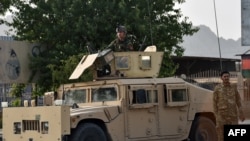U.S. officials voicing optimism that Afghan security forces would be able to prevent insurgent Taliban forces from sweeping across Afghanistan may be basing their assessment more on hope than on any measurable data.
A “lessons learned” report released Wednesday by the Special Inspector General for Afghanistan Reconstruction, a government watchdog, warns that after almost 20 years and more than $88 billion in spending, the U.S. military has few tangible indicators of how Afghan security forces will do on their own.
“The question of how to accurately project how the ANDSF (Afghan National Defense and Security Forces) would perform against an adversary in the absence of direct U.S. combat enabler support remains difficult to answer,” the report said.
“The systems designed to measure that capability have been criticized for being inconsistent,” the report added. “Rating systems designed to capture ANDSF operational effectiveness have shifted over time, reflecting persistent questions about what data mattered, how to balance quantitative and qualitative information, and, more fundamentally, how exactly to measure capability in the first place.”
The SIGAR report also noted that attempts to assess the readiness of Afghan forces were “limited by a complex environment that made it difficult to gather actionable data and identify useful metrics” while the credibility of some of the assessments that were done was “undermined by overoptimism.”
Attempts to measure how well Afghan forces are holding up as U.S. and coalition troops withdraw have likewise been grim.
One tracker, by the Washington-based Foundation for Defense of Democracies’ Long War Journal, estimates that the Taliban have more than doubled the number of districts under their control, from 73 to 204, since the start of May.
And each day seems to bring with it new claims of victory by Taliban forces, with Taliban officials posting videos of celebrations from places such as Spin Boldak, in the country’s southern Kandahar province, and Sighan, in central Bamiyan province, on Twitter.
Afghan defense officials have fought back, taking to social media to post their own accounts of victory.
“38 #Taliban terrorists were killed and 15 others including one of their commanders named ‘Qayum’ son of ‘Sofi’ were wounded in #airstrikes conducted by #AAF at the outskirts of #Takhar provincial center,” Afghan Defense Ministry spokesman Fawad Aman tweeted Wednesday.
Another post claimed Afghan forces killed 16 Taliban and wounded four more during an operation in Nangarhar province.
Meanwhile, Pentagon officials continue to voice support for the more than 300,000-strong ANDSF.
“They have the advantage. They have numerous advantages,” Pentagon press secretary John Kirby told reporters Wednesday, while declining to share any assessment of how Afghan forces have been faring in battle.
“They have better capabilities than the Taliban in the air and on the ground. And they are certainly going to continue to have American support financially, logistically and through assistance and maintenance,” Kirby said. “It’s really going to come down to their ability and their willingness to use those advantages to their benefit.”
In its report released Wednesday, SIGAR, the U.S. government watchdog, found that U.S. military trainers did have some successes.
Notably, programs to train, advise and assist specialized Afghan forces “resulted in fairly proficient Afghan Special Forces and a promising Afghan Air Force.”
But there have been questions about how long those forces, and the Afghan air force in particular, can survive without the presence of U.S. military personnel and U.S. military contractors on the ground.
Earlier this year, John Sopko, the U.S. special inspector general for Afghanistan reconstruction, warned that the Afghan air force would not be able to sustain its aircraft for more than a few months once thousands of U.S. and foreign contractors left the country.
The Pentagon this week has said several hundred contractors remain, though they are expected to leave when the U.S. withdrawal concludes at the end of next month.








